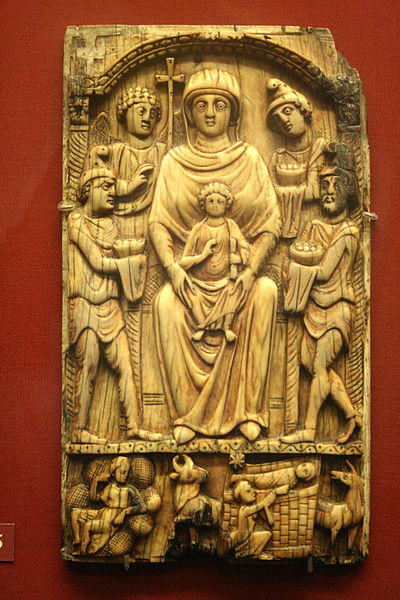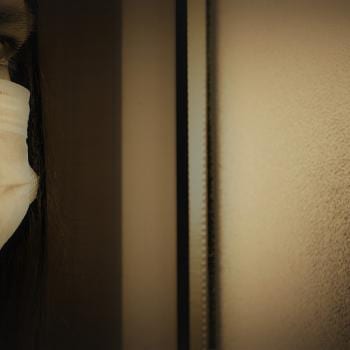As a child, I was very taken with stories from the Bible. It was The Bible in Pictures for Little Eyes when I was a toddler (that’s the one with the unforgettable image of two Israelites toting giant bunches of grapes on a stick between them, the image of the abundance and fertility of the Promised Land). Then we had The Picture Bible, a three-volume comic book collection of Bible stories from the seventies, in which everyone wears impossibly bright colors, and the men all have pornstaches. By the time I was twelve I had read the KJV cover to cover several times, and emerged with a far greater understanding of war, rape, circumcision, incest, drunkenness, breasts like towers, the kisses of his mouth, and how to seduce a man after gleaning in his meadow, even if I wasn’t entirely sure how to glean in a meadow.
The Old Testament struck me as far more interesting than the New. And the women of the Old Testament – rebels, liars, prostitutes, and murderers – seemed far more thrilling than the mostly well-behaved women in Christ’s orbit. If some shadowy sexist human author of Genesis puts the blame on Eve for plunging us into original sin, the stories after that seem to emphasize that the kingdom of God is made manifest through unruly women, who advance salvation history by laughing at angels, tricking their husbands, lying to their fathers, and sneaking onto men’s beds at night. I had to wait for my mother to dig up her Hebrew scripture in order to hear the story of Judith, which is absent from Protestant Bibles, and eventually began to entertain a suspicion that being a Jewish woman was just more intriguing than being a Christian one.
I suppose I had a sort of pop-Nietzschean feminist thesis: that everyone was always trying to get women to knuckle under, and we never totally did, until Christianity watered us down and made us weak. Sure, in the New Testament we have one woman who lived with a man not her husband, and another (supposedly) posessed. We have Martha complaining about housework. But what’s that to slicing off the head of a general? I didn’t like the fact that Mary was supposed to be our examplar, because she never seemed to do anything. Her virtues all seemed negative: meekness, obedience, silence, purity.
If for Nietzsche Christ was the image of men made weak and this weakness called virtue, for me Mary was the image of women sublimed away to nothingness, and this nothingness called holiness.
Then we became Catholic, and the pastel submissive figure who had hovered round creches and in picture Bibles suddenly loomed everywhere: pink-cheeked, eyes downcast, mouth curved in a gentle, modest smile. I heard about how from time to time she would appear, usually to peasant children, and complain about offensive fashion. I encountered St. Louis de Montfort and the “Consecration to Jesus through Mary” and hated it. I didn’t want to be anyone’s slave. I especially didn’t want to be the slave of some mealy-mouthed girl who always did the right thing, happily, uncomplainingly, and who was so perfect that she didnt’t even menstruate, and bore Jesus as a painless ray of light through her ear.
I was trying hard to be a “good Catholic” (whatever that even is) – but my guilty secret was that I didn’t much like Mary. Or most of the female saints, either. And since all the rest of our faith appeared to be male dominated, that meant I didn’t like the one representative of my sex permitted into the sanctuary.
Fast forward twenty years. A lot happened. My view of Christianity altered, dramatically, so that I understand now that the religion Nietzsche criticized was a bourgeois reflection of the real thing. The god who died was not the Eternal One, but the tame godlet harnessed by history and capitalism and politics and militarism. I began to see how false parodies and shimmering images of Christianty had been presented to me in the guise of the real thing.
But I have also learned to be suspicious of the Nietzschean adulation of power, even when properly understood as an artistic self-creating power, not the violent power of which fascists dream. I got past the superficial view of the Old Testament heroines as “badass superwomen” and began to see them rather as complex individuals, doing what they needed to do to survive. Judith probably did not actually enjoy cutting off Holofernes’ head. Cutting off heads is not supposed to be enjoyable.
And so I was prepared to take a new look at the panoply of woman saints, but especially at Mary. And what did I see?
Not the mealy-mouthed yes-woman I’d been presented with so often – nor someone so irritatingly perfect she never felt pain – nor someone with a twisted and nihilistic yearning to make us all her slaves.
But, neither did I recast her as a “badass superwoman” or “sassy,” or in any of the two-dimensional guises we’re invited to put on in a parody of feminism. We see so little of Mary in the Gospels, but when we do see her she is not being annoyingly perfect, nor annoyingly bad-ass. She is complex, multifaceted, and almost secretive. We hear often of “Mary-like modesty,” from those who mistakenly presume this virtue to be about clothing, but perhaps Mary’s modesty is that she does not lord it over others, in spite of her objective moral superiority. She never manipulates, or shames. One is left wondering whether she’s a little embarassed about being set apart from other women. Is she secretive because she senses her own difference, and carries it delicately, with caution, perhaps even fear of exposure, or fear of being used? Patriarchal structures are always so quick to use women.
Embarassment and fear are very human traits, though not sinful ones. They don’t fit the picture of Badass Superwoman – but, they also don’t make Mary weak, or fainting. From the very beginning we see how courageous she is, agreeing to bear the Son of God even knowing that if Joseph didn’t believe her story she might end up being publicly stoned. In an era in which women’s bodies were regarded as property of men, Mary took possession of her own body in order to give the gift of her life-giving, and receive the gift of her redeemer. We never see her in her home, confined to domestic tasks. We see her hurrying to visit Elizabeth (on her own, traveling across occupied territory). We see her pondering things in her heart. We see her misplace her child, distracted by conversation with friends. We see her give commands to God.
The feast of Mary Theotokos should be an occasion for women to ponder what it means that a human woman, one of us, was chosen to bear in her body the Second Person of the Trinity. What does this mean about womanhood, our bodies, our fertility cycles, pregnancy? Too often we think of pregnancy as a situation of containment: women are passive vessels into which the divine seed is squirted by the rampdant god-like male. Passively we rise like yeasted dough, as life grows within us. Then out comes the baby, and we can be congratulated for having fulfilled our purpose as women. This view is unfortunately very common to both sides of the abortion debate: “the woman is a container who has to contain” vs. “the woman is a container who doesn’t have to contain.”
But Mary as the Mother of God reminds us that she wasn’t just an inert container for the divine. Mary actually “mothered” God. What does this mean, this mothering, beyond the passive containment the ancients and scholastics imagined? Think of the process of gestation, the intricate connection between bodies, the umbilical cord, the placenta, everything within a woman’s body shifting and altering to accomodate the life she is producing. It is an active, not a passive process. We stretch and tear. Fluids flow from us. Our flesh grows the flesh of the child.
And this process has been regarded, historically, in many cultures, as ritualistically defiling. The female body itself is a defilement, a danger, a thing unclean, according to many religious traditions. To be woman is to be earth, matter, flesh, and therefore death.
But with the celebration of Mary as the Mother of God we see the female body, and all its powers, and hidden processes, and impure fluids, as something holy. Our giving birth is not just a passing-through, but a giving forth. Even if Jesus passed painlessly out of his mother (if, alone of all men, he never did a woman harm) – we might do well to think of Mary’s mothering of her Son as more than just a passive process. Jesus took his earthly substance from his mother’s body, carried her genetics, probably resembled her. His body was born of her body.
Looking at Mary as Mother of God perhaps provides us with a way of seeing mothering itself, the female body itself, as a living ikon of God-bearing. I’m not sure this is something that is stressed sufficiently, in conversations about roles of women, in spite of the emphasis on motherhood. The vocation to natural motherhood is emphasized as something worthy and holy, and we are told we must imitate Mary, but often these admonitions come with the insinuation that we are being told to keep in our proper – submissive – place. Not every woman has a vocation to child-bearing, anyway. Not every woman wants to do it, and not every woman can, so conversation about natural motherhood is only relevant for some women. But what about the theology of the female body as a bearer of God? That’s something I’d like to hear more about.
https://commons.wikimedia.org/wiki/File:Byzantine_ivory_802.jpg













